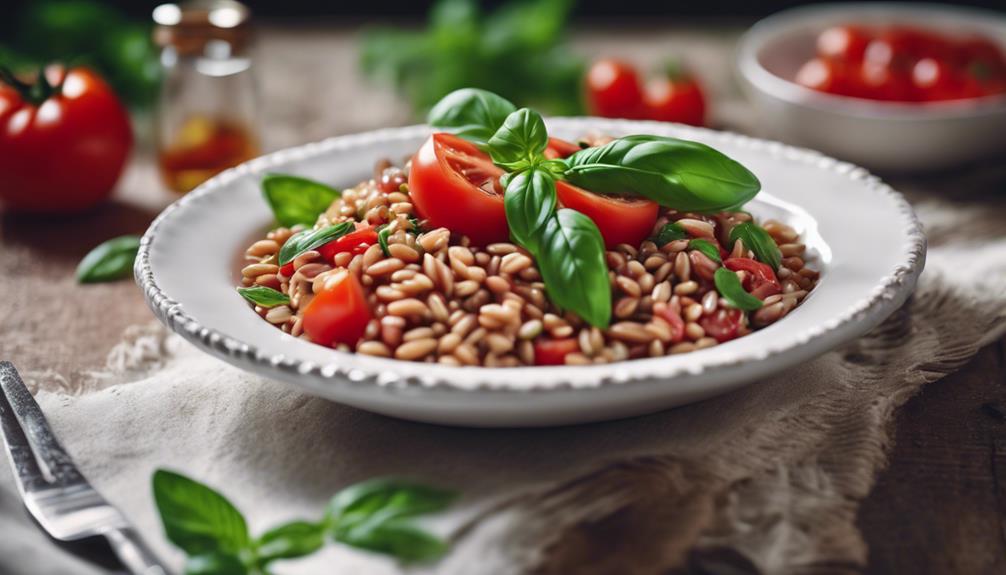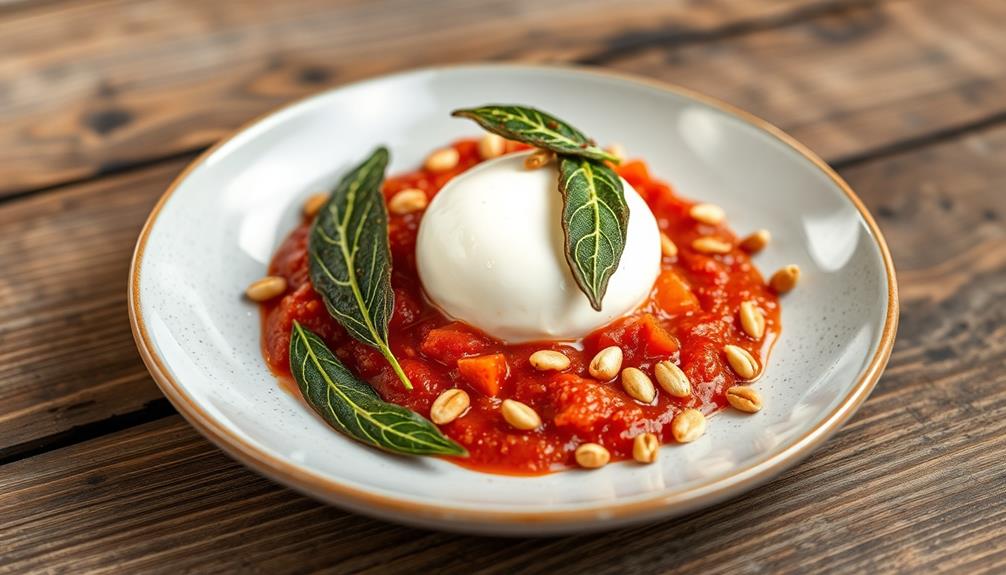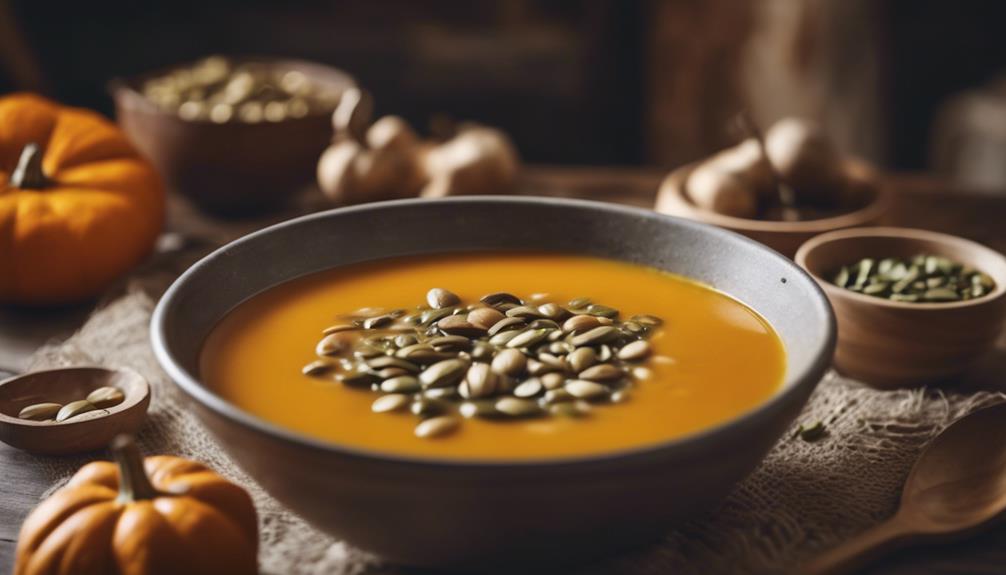Indulge in the nutritious combination of fiber, protein, vitamins, and antioxidants found in Tomato Basil Farro. This healthy side dish supports overall well-being with its rich nutrient profile. Farro’s fiber content aids in digestion, regulates blood sugar levels, and promotes heart health. The protein in farro helps with muscle repair, satiety, and sustained energy levels. Prepare it until it is tender yet chewy, and add roasted vegetables, nuts, or cheese for different textures. For added convenience, store cooked farro and experiment with various flavors to enjoy it with grilled proteins or seafood. Keep it fresh in the refrigerator or freezer for longer preservation. Enhancements like feta cheese, sun-dried tomatoes, or balsamic glaze can enhance its flavor.
Key Takeaways
- High in fiber, protein, and iron for overall well-being.
- Rich in vitamins C and K, antioxidants, and lycopene.
- Supports heart health with low saturated fats and cholesterol.
- Provides essential nutrients and anti-inflammatory properties.
- Combines colorful and flavorful ingredients for a nutritious side dish.
Benefits of Tomato Basil Farro
Explore the numerous health benefits of indulging in Tomato Basil Farro. Farro, a nutrient-dense ancient grain, offers high levels of fiber, protein, and iron, making it an excellent choice for supporting overall health.
When combined with tomatoes, rich in vitamins C and K, antioxidants, and lycopene, and basil, which provides anti-inflammatory properties, antioxidants, and essential nutrients like vitamin K, Tomato Basil Farro becomes a powerhouse of nutrition.
This colorful and flavorful dish not only delights the taste buds but also supports your well-being by being low in saturated fats and cholesterol.
The combination of farro, tomatoes, and basil creates a delicious, hearty, and satisfying side dish that can be enjoyed as a light meal or paired with protein for a complete and balanced dietary option.
Embrace the benefits of Tomato Basil Farro for a wholesome and nourishing addition to your diet.
Nutrient Profile of Farro

Farro boasts a remarkable nutrient profile, offering a wealth of benefits for your overall health.
With a high fiber content of around 5 grams per cup, farro can aid in digestion and promote feelings of fullness.
Additionally, its protein content of approximately 8 grams per cup makes it a valuable source of this essential macronutrient.
Farro's Nutritional Benefits
With its impressive nutrient profile, farro emerges as a powerhouse of essential vitamins and minerals, protein, fiber, and complex carbohydrates. Farro's nutty flavor adds a delightful touch to dishes while also providing numerous health benefits.
This ancient grain is rich in protein, making it a valuable source for muscle repair and growth. Additionally, farro contains essential minerals like iron and magnesium, important for various bodily functions such as oxygen transport and nerve function. Its complex carbohydrates offer sustained energy, ideal for maintaining peak performance throughout the day.
Moreover, farro is naturally low in fat and cholesterol, supporting heart health and overall well-being. Being gluten-friendly, farro can be a suitable choice for individuals with mild gluten sensitivities.
Incorporating this versatile ingredient into your meals not only enhances flavor but also supplies your body with a range of essential nutrients necessary for a balanced diet.
Farro's Fiber Content
Considering farro's impressive nutrient profile, one notable aspect worth highlighting is its high fiber content, offering approximately 5-8 grams per 1/4 cup serving. The fiber content in farro plays an essential role in maintaining a healthy body.
Here are some key points to understand the significance of farro's fiber content:
- Digestive Health: The fiber in farro aids in digestion, promoting regular bowel movements and preventing constipation.
- Blood Sugar Regulation: Farro's fiber content helps regulate blood sugar levels, making it a great choice for individuals managing diabetes or looking to stabilize energy levels.
- Heart Disease Prevention: Consuming fiber-rich foods like farro can lower the risk of heart disease by reducing cholesterol levels and improving heart health.
- Weight Management: Farro's fiber content contributes to a feeling of fullness, aiding in weight management and preventing overeating.
- Overall Well-being: Including farro in your diet helps meet daily fiber requirements, supporting a healthy gut and overall well-being.
Incorporating farro into your meals can be a simple and effective way to boost your fiber intake and promote a healthy lifestyle.
Farro's Protein Content
A substantial amount of protein in cooked farro supports muscle repair and growth, making it a valuable addition to your diet. Whole grain farro is a nutrient-dense food that offers approximately 8 grams of protein per 1-cup serving. This protein content is essential for meeting your daily protein needs and can be particularly beneficial for individuals looking to increase their protein intake.
The protein in farro not only aids in muscle repair but also provides essential amino acids necessary for overall health. Alongside its protein content, farro is rich in fiber, vitamins, and minerals, making it a well-rounded choice for a balanced diet. Incorporating farro into your meals can promote feelings of fullness, aid in weight management, and sustain energy levels throughout the day.
Whether you're an active individual or simply seeking a nutritious option, the protein-packed whole grain farro can be a versatile and beneficial addition to your diet.
Cooking Farro Perfectly

When cooking farro, it's essential to pay attention to the cooking time, water to farro ratio, and achieving the proper texture.
Different types of farro may require varying cooking times, with pearled farro taking around 20-30 minutes and whole grain farro up to an hour.
Ensuring that farro is cooked until tender yet slightly chewy, known as al dente, will result in the best texture for your dishes.
Cooking Time for Farro
To cook farro perfectly, adjust the cooking time based on the type of farro used and aim for a tender yet slightly chewy texture. Farro typically cooks in about 20-30 minutes until reaching this desired consistency.
Here are some tips to help you achieve the ideal cooking time for your farro:
- Consider the type of farro being used, whether whole grain, semi-pearled, or pearled, as this can impact the cooking time.
- Whole grain farro usually requires soaking overnight and longer cooking times to soften adequately.
- Opt for semi-pearled farro for a quicker cooking option, taking around 20-25 minutes and eliminating the need for soaking.
- Follow the package instructions for specific cooking times and adjust as needed based on the desired texture.
- Test for doneness by tasting the grains; they should be tender yet slightly chewy when fully cooked.
Water to Farro Ratio
The water to farro ratio plays a significant role in achieving the perfect texture when cooking farro. For best results, a general guideline is to use 3 cups of water for every 1 cup of farro. This ratio ensures that the farro cooks to a tender yet chewy consistency, striking the ideal balance.
However, it's important to take into account the type of farro being used when determining the water amount. Whole grain farro typically requires more water and a longer cooking time compared to semi-pearled farro. Adjusting the water quantity based on the variety of farro helps achieve the desired texture.
Maintaining the recommended water to farro ratio is crucial as it prevents the farro from ending up either mushy or undercooked. By adhering to these guidelines, you can master the art of cooking farro to perfection, ensuring a delightful culinary experience.
Proper Farro Texture
Achieving the perfect texture when cooking farro hinges on boiling it in salted water until it reaches an al dente consistency. Properly cooked farro should be tender yet slightly chewy, akin to the texture of cooked barley or brown rice.
To avoid a mushy outcome, it's important to monitor the cooking time closely, ensuring the farro retains its shape and offers a pleasant, nutty flavor with a slight bite. The ideal cooking time for farro may vary based on the type used, whether semi-pearled, pearled, or whole grain.
When preparing a farro salad with fresh basil, the texture plays an essential role in enhancing the overall dish, providing a satisfying contrast to the basil's aromatic freshness.
Customization Options for Farro
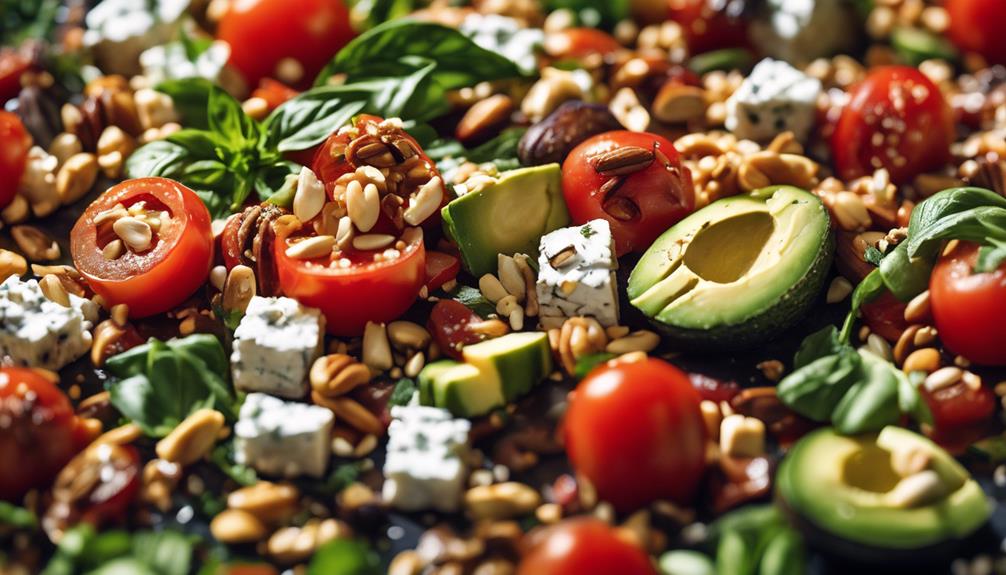
Consider incorporating a variety of vegetables, proteins, herbs, spices, nuts, and cheeses to customize your farro dish to suit your preferences and elevate its flavors.
When adding vegetables to your farro, options like roasted bell peppers, artichokes, or cucumbers can introduce different textures and flavors to your dish.
To turn your farro into a hearty main course, consider including protein sources such as grilled chicken, shrimp, or chickpeas.
Enhance the overall taste by experimenting with herbs and spices like parsley, mint, or red pepper flakes.
For a satisfying crunch, incorporate nuts or seeds like toasted pine nuts, almonds, or sunflower seeds into your farro salad.
If you prefer a creamier consistency, mix in crumbled feta, goat cheese, or avocado for a rich and indulgent variation.
Meal Prep Tips for Farro
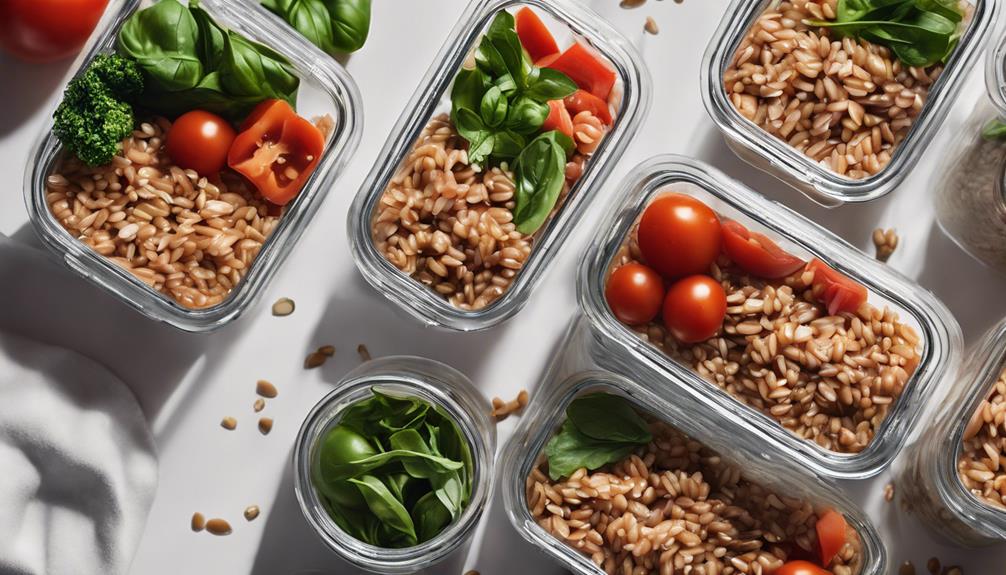
For efficient meal prep with farro, plan ahead by cooking a batch that can be stored and easily incorporated into meals throughout the week.
Here are some meal prep tips to make the most out of your farro:
- Cook in Advance: Prepare a large batch of farro at the beginning of the week and store it in the fridge for up to 5 days.
- Portion Control: Divide the cooked farro into individual containers for quick grab-and-go lunches or easy side dishes.
- Enhance Nutritional Value: Mix in roasted vegetables, grilled chicken, or chickpeas to create a well-rounded and balanced meal prep option.
- Freeze for Longevity: Freeze farro for up to 6 months to extend its shelf life and have it readily available for future meal preps.
- Experiment with Flavors: Keep things interesting by adding different herbs, spices, or dressings to your farro to introduce variety and excitement to your meal preps.
Serving Suggestions for Farro
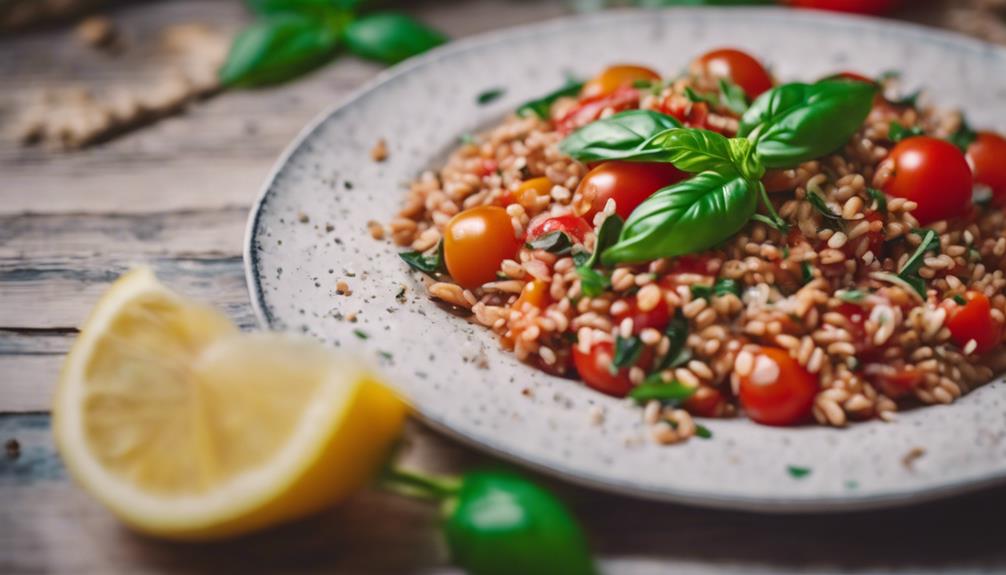
To enhance the dining experience with farro, consider incorporating fresh ingredients and complementary flavors to create a satisfying and flavorful meal. When serving farro as a side dish, you can elevate its taste by adding vibrant ingredients such as tomatoes and basil. The juicy sweetness of ripe tomatoes combined with the aromatic freshness of basil can bring a burst of flavor to your farro dish. Additionally, garnishing the farro with extra basil leaves not only enhances its visual appeal but also enriches the overall flavor profile.
For a more substantial meal, farro pairs excellently with grilled chicken or fish, offering a nutritious and fulfilling option. The nutty and chewy texture of farro complements the tenderness of grilled proteins, creating a well-balanced plate. To add more depth to your farro dish, consider incorporating variations like crumbled feta cheese or sun-dried tomatoes. These additions can further elevate the taste and texture of your farro salad, providing a delightful and satisfying dining experience.
Storage Guidelines for Farro

When storing farro, make sure you place cooked leftovers in an airtight container in the refrigerator for up to 5 days.
To maintain the freshness and quality of your farro, consider the following storage guidelines:
- Freeze cooked farro in a freezer-safe container or bag for up to 6 months.
- Thaw frozen farro overnight in the refrigerator before reheating to preserve its texture.
- Reheat farro using methods such as the microwave, stovetop, or oven until warmed through evenly.
- When reheating farro, add a splash of water or broth to prevent it from drying out and enhance its flavors.
- Store any leftover reheated farro in the refrigerator promptly and consume within 3-4 days for the best taste and quality.
Variations of Tomato Basil Farro

Looking to add a twist to your classic Tomato Basil Farro recipe? Enhance the flavors by incorporating some creative variations.
Try adding crumbled feta cheese to your farro for a creamy and tangy touch that complements the tomato basil combination.
For a more intense flavor profile, swap out cherry tomatoes for sun-dried tomatoes, offering a concentrated burst of taste.
To elevate the dish with a peppery kick and added texture, mix in some arugula into your tomato basil farro salad.
For a sweet and tangy finish that complements the tomatoes and basil, drizzle the dish with balsamic glaze.
Finally, top off your tomato basil farro with toasted pine nuts for a crunchy and nutty element that enriches the overall flavor profile.
These variations will take your farro dish to the next level, offering a delightful blend of tastes and textures that are sure to impress your taste buds.
Final Thoughts on Farro Recipe
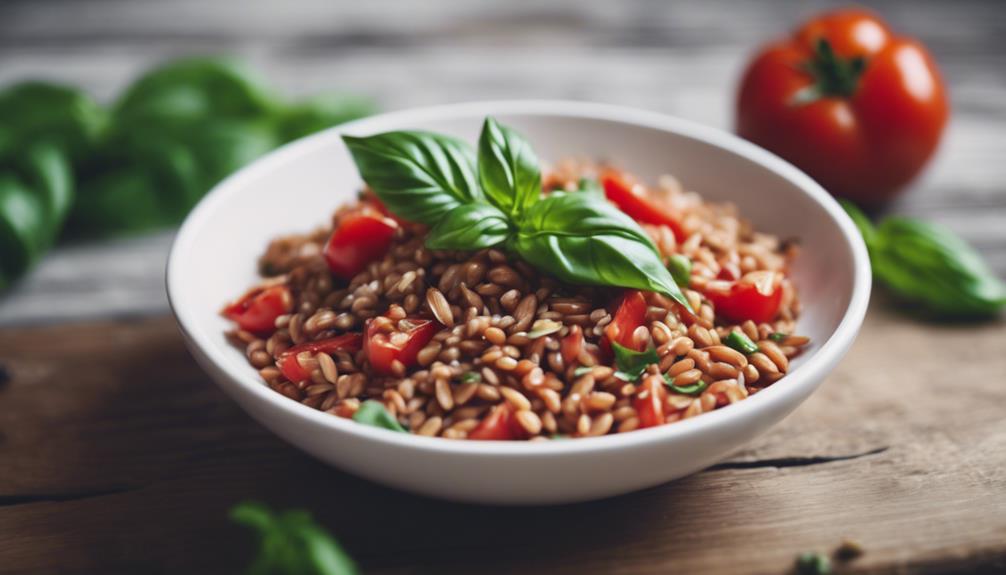
Consider incorporating farro into your regular meal rotation for a nutritious and flavorful addition that can elevate your culinary repertoire. As you reflect on the Tomato Basil Farro recipe and its benefits, here are some final thoughts to solidify your understanding:
- The versatility of farro allows you to experiment with various ingredients, spices, and cooking methods to create unique dishes.
- Incorporating farro into your diet can provide essential nutrients like iron and protein, supporting a balanced and healthy lifestyle.
- The ease and convenience of cooking Tomato Basil Farro in just 30 minutes make it a practical choice for busy weeknight dinners.
- Farro's nutty flavor and chewy texture bring a delightful contrast to the fresh basil and tangy tomatoes in this dish.
- Exploring different farro recipes, such as Tomato Basil Farro, can broaden your culinary skills and introduce you to the world of ancient grains.
Frequently Asked Questions
Is Farro Good on Mediterranean Diet?
Yes, farro is a fantastic choice for the Mediterranean diet. It's packed with fiber, protein, and nutrients that align perfectly with the diet's principles. Including farro in your meals can benefit your heart health, weight, and overall wellness.
What Is Italian Farro?
Italian farro is an ancient wheat grain with a nutty taste and chewy texture. It's rich in fiber, protein, magnesium, iron, and zinc. Common in Mediterranean cuisine, you can enjoy it in salads, soups, and side dishes.
Can I Use Charlie Bird Farro Salad as a Substitute for Tomato Basil Farro?
Yes, you can use the Charlie Bird farro salad recipe as a substitute for tomato basil farro. The unique combination of flavors in the Charlie Bird farro salad recipe will add a fresh and savory twist to your dish, making it a delightful alternative to the traditional tomato basil farro.
Conclusion
To sum up, Tomato Basil Farro is a versatile and nutritious side dish that can be easily customized to suit any palate. With its hearty texture and rich flavors, this dish is a perfect addition to any meal.
So why not give it a try and bring a touch of Mediterranean flair to your table? Remember, variety is the spice of life, and Tomato Basil Farro is sure to spice up your next meal!
